华中农业大学:《食品微生物学》课程PPT教学课件(Food Microorganism)Chapter 4 Eukaryotic Microorganisms
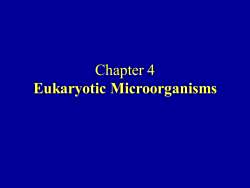
Chapter 4 Eukaryotic Microorganisms
Chapter 4 Eukaryotic Microorganisms
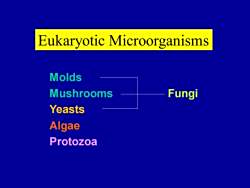
Molds Mushrooms Fungi Yeasts Algae Protozoa Eukaryotic Microorganisms
Molds Mushrooms Fungi Yeasts Algae Protozoa Eukaryotic Microorganisms
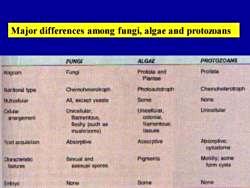
Major differences among fungi, algae and protozoans
Major differences among fungi, algae and protozoans
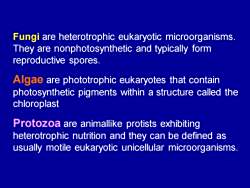
Fungi are heterotrophic eukaryotic microorganisms. They are nonphotosynthetic and typically form reproductive spores. Algae are phototrophic eukaryotes that contain photosynthetic pigments within a structure called the chloroplast Protozoa are animallike protists exhibiting heterotrophic nutrition and they can be defined as usually motile eukaryotic unicellular microorganisms
Fungi are heterotrophic eukaryotic microorganisms. They are nonphotosynthetic and typically form reproductive spores. Algae are phototrophic eukaryotes that contain photosynthetic pigments within a structure called the chloroplast Protozoa are animallike protists exhibiting heterotrophic nutrition and they can be defined as usually motile eukaryotic unicellular microorganisms
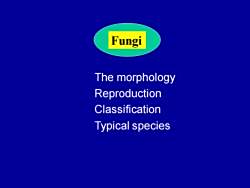
The morphology Reproduction Classification Typical species Fungi
The morphology Reproduction Classification Typical species Fungi
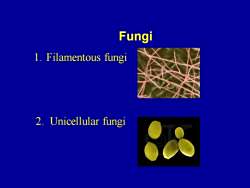
Fungi 1. Filamentous fungi 2. Unicellular fungi
Fungi 1. Filamentous fungi 2. Unicellular fungi
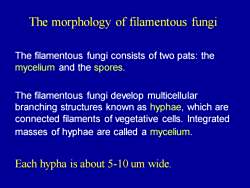
The morphology of filamentous fungi The filamentous fungi consists of two pats: the mycelium and the spores. The filamentous fungi develop multicellular branching structures known as hyphae, which are connected filaments of vegetative cells. Integrated masses of hyphae are called a mycelium. Each hypha is about 5-10 um wide
The morphology of filamentous fungi The filamentous fungi consists of two pats: the mycelium and the spores. The filamentous fungi develop multicellular branching structures known as hyphae, which are connected filaments of vegetative cells. Integrated masses of hyphae are called a mycelium. Each hypha is about 5-10 um wide
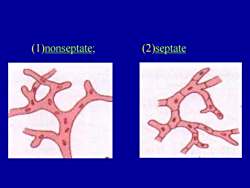
(1)nonseptate; (2)septate
(1)nonseptate; (2)septate
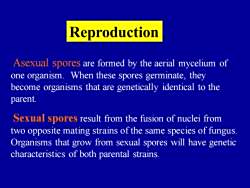
Reproduction Asexual spores are formed by the aerial mycelium of one organism. When these spores germinate, they become organisms that are genetically identical to the parent. Sexual spores result from the fusion of nuclei from two opposite mating strains of the same species of fungus. Organisms that grow from sexual spores will have genetic characteristics of both parental strains
Reproduction Asexual spores are formed by the aerial mycelium of one organism. When these spores germinate, they become organisms that are genetically identical to the parent. Sexual spores result from the fusion of nuclei from two opposite mating strains of the same species of fungus. Organisms that grow from sexual spores will have genetic characteristics of both parental strains
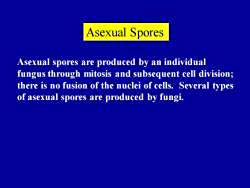
Asexual spores are produced by an individual fungus through mitosis and subsequent cell division; there is no fusion of the nuclei of cells. Several types of asexual spores are produced by fungi. Asexual Spores
Asexual spores are produced by an individual fungus through mitosis and subsequent cell division; there is no fusion of the nuclei of cells. Several types of asexual spores are produced by fungi. Asexual Spores
按次数下载不扣除下载券;
注册用户24小时内重复下载只扣除一次;
顺序:VIP每日次数-->可用次数-->下载券;
- 华中农业大学:《食品微生物学》课程PPT教学课件(Food Microorganism)Chapter 3 The Prokaryotes.ppt
- 华中农业大学:《食品微生物学》课程PPT教学课件(Food Microorganism)Chapter 2 Cell Biology.ppt
- 华中农业大学:《食品微生物学》课程PPT教学课件(Food Microorganism)Chapter 1 Biology of microorganism.ppt
- 桂林医学院:《生物化学与分子生物学》课程教学资源(PPT课件)第九章 代谢调节.ppt
- 桂林医学院:《生物化学与分子生物学》课程教学资源(PPT课件)第八章 核苷酸代谢.ppt
- 桂林医学院:《生物化学与分子生物学》课程教学资源(PPT课件)第七章 氨基酸代谢.ppt
- 桂林医学院:《生物化学与分子生物学》课程教学资源(PPT课件)第六章 生物氧化.ppt
- 桂林医学院:《生物化学与分子生物学》课程教学资源(PPT课件)第五章 脂类代谢.ppt
- 桂林医学院:《生物化学与分子生物学》课程教学资源(PPT课件)第四章 糖代谢.ppt
- 桂林医学院:《生物化学与分子生物学》课程教学资源(PPT课件)第三章 酶化学.ppt
- 桂林医学院:《生物化学与分子生物学》课程教学资源(PPT课件)第二章 核酸的结构与功能.ppt
- 桂林医学院:《生物化学与分子生物学》课程教学资源(PPT课件)第二十三章 基因组学.ppt
- 桂林医学院:《生物化学与分子生物学》课程教学资源(PPT课件)第二十二章 常用分子生物学技术的原理及其应用.ppt
- 桂林医学院:《生物化学与分子生物学》课程教学资源(PPT课件)第二十一章 基因诊断与基因治疗.ppt
- 桂林医学院:《生物化学与分子生物学》课程教学资源(PPT课件)第二十章 癌基因与抑癌基因.ppt
- 桂林医学院:《生物化学与分子生物学》课程教学资源(PPT课件)第一章 蛋白质的结构与功能.ppt
- 桂林医学院:《生物化学与分子生物学》课程教学资源(PPT课件)第十七章 肝的生化.ppt
- 桂林医学院:《生物化学与分子生物学》课程教学资源(PPT课件)第十四章 基因重组与基因工程.ppt
- 桂林医学院:《生物化学与分子生物学》课程教学资源(PPT课件)第十三章 基因表达调控.ppt
- 桂林医学院:《生物化学与分子生物学》课程教学资源(PPT课件)第十二章 蛋白质的生物合成.ppt
- 华中农业大学:《食品微生物学》课程PPT教学课件(Food Microorganism)Chapter 5 Viruses.ppt
- 华中农业大学:《食品微生物学》课程PPT教学课件(Food Microorganism)Chapter 6 Microbial Growth and Metabolism.ppt
- 华中农业大学:《食品微生物学》课程PPT教学课件(Food Microorganism)Chapter 7 Microbial Growth and Growth control.ppt
- 华中农业大学:《食品微生物学》课程PPT教学课件(Food Microorganism)Chapter 8 Bacterial genetics.ppt
- 华中农业大学:《食品微生物学》课程PPT教学课件(Food Microorganism)Chapter 9 Microbial Ecology.ppt
- 河北农业大学:《食品微生物学》课程教学资源(PPT课件)第一章 绪论(任课教师:贾英民).ppt
- 河北农业大学:《食品微生物学》课程教学资源(PPT课件)第二章 微生物主要类群的形态、结构和功能.ppt
- 河北农业大学:《食品微生物学》课程教学资源(PPT课件)第三章 微生物的营养.ppt
- 河北农业大学:《食品微生物学》课程教学资源(PPT课件)第四章 微生物的代谢.ppt
- 河北农业大学:《食品微生物学》课程教学资源(PPT课件)第五章 微生物的生长及其影响因素.ppt
- 河北农业大学:《食品微生物学》课程教学资源(PPT课件)第六章 微生物的遗传变异与菌种选育.ppt
- 河北农业大学:《食品微生物学》课程教学资源(PPT课件)第七章 发酵食品微生物.ppt
- 河北农业大学:《食品微生物学》课程教学资源(PPT课件)第八章 微生物与食品腐败变质.ppt
- 河北农业大学:《食品微生物学》课程教学资源(PPT课件)第九章 食品卫生微生物.ppt
- 广东轻工职业技术学院:《微生物学》课程教学课件(PPT讲稿)第一章 绪论(主讲:石琳).ppt
- 广东轻工职业技术学院:《微生物学》课程教学课件(PPT讲稿)第二章 微生物类群及形态结构.ppt
- 广东轻工职业技术学院:《微生物学》课程教学课件(PPT讲稿)第三章 微生物的营养.ppt
- 广东轻工职业技术学院:《微生物学》课程教学课件(PPT讲稿)第四章 微生物的代谢.ppt
- 广东轻工职业技术学院:《微生物学》课程教学课件(PPT讲稿)第五章 微生物的生长和纯培养.ppt
- 广东轻工职业技术学院:《微生物学》课程教学课件(PPT讲稿)第六章 理化因素对微生物的影响.ppt
